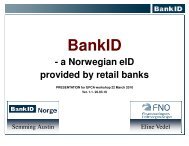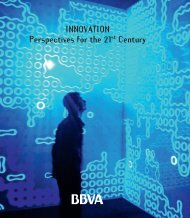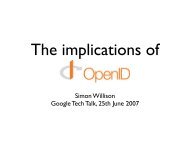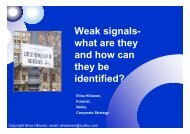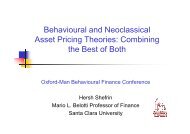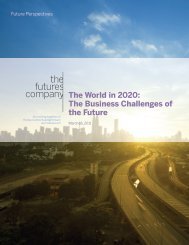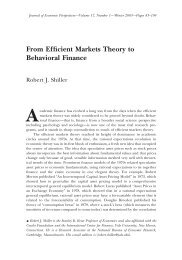TransformaTion
TransformaTion
TransformaTion
Create successful ePaper yourself
Turn your PDF publications into a flip-book with our unique Google optimized e-Paper software.
The Question of<br />
Transformation<br />
A perspective on the pursuit<br />
of breakthrough innovation.<br />
There’s a rarely-discussed but fundamental<br />
truth about the pursuit of growth-driving<br />
transformational innovation:<br />
the likelihood of an innovation project<br />
landing on transformational answers<br />
pivots almost entirely on whether it<br />
starts with transformational questions…
After years being delighted<br />
by the diversity of the<br />
innovation challenges<br />
coming over the transom—<br />
in our case, a decidedly<br />
mad mix spanning wellness<br />
to whiskey, soft drinks to<br />
software, money to music,<br />
hotels to haute jewels,<br />
microchips to potato chips,<br />
and literally soup to nuts—<br />
you suddenly find yourself<br />
gob-smacked by the thread of<br />
similarity running through it.<br />
Across companies, categories and countries, an<br />
armada of innovation teams sets forth daily, each<br />
with great promise, an aggressive, growth-minded<br />
leadership team, a formidable body of knowledge<br />
about its market space, and a tangible asset base<br />
spanning brands, infrastructure, technologies<br />
and market presence. Yet the majority struggle<br />
to unlock the transformational answer.<br />
The struggle triggers a call for help from<br />
outfits like ours, and a conversation that,<br />
in one way or another, dances toward the<br />
same big question:<br />
So how will you guys crack<br />
the transformational answers<br />
we haven’t managed to<br />
unlock ourselves?<br />
What they mean of course<br />
is: C’mon guys, what’s the<br />
big answer’s proverbial<br />
secret sauce?<br />
What’s the repeatable rain dance that allows you,<br />
or anyone else for that matter, to crack the lightning<br />
strike transformational answer that we somehow<br />
can’t quite see for looking?<br />
What we tell them, and offer here to anyone in<br />
innovation with transformational ambitions, is that<br />
they’re asking the wrong question.<br />
The real alchemy of transformational innovation<br />
isn’t about the answers at all.<br />
The answers are, believe it or not, the relatively<br />
easy part.<br />
The tough bit is what<br />
comes before:<br />
Finding<br />
transformational<br />
questions.
A QUESTION OF<br />
Competitive<br />
It’s about framing big, high altitude questions<br />
that pack a healthy disrespect for present reality,<br />
that dare to challenge the fundamental nature of<br />
the categories, businesses, behaviors, experiences<br />
and companies around which we’re asked to innovate,<br />
and that ultimately define a path to positive<br />
market disruption.<br />
Advantage<br />
What becomes clear in a long march across<br />
dozens of companies and categories is that a<br />
staggering amount of competitive advantage<br />
lies in the definition of fundamentally<br />
new questions around which to engage<br />
the marketplace, and mobilize your team’s<br />
pursuit of breakthrough innovation.<br />
We’re not talking about<br />
clever new probing techniques or the familiar<br />
‘what if…’ questions—which are, in truth, just<br />
potential answers with question marks at the<br />
end—it’s much more fundamental and strategic.<br />
In our experience,<br />
transformational questions<br />
have superhero powers.<br />
They materially change the conversation, both inside<br />
a company and with the customers it’s out to serve.<br />
They challenge underlying assumptions that have,<br />
artificially and unhelpfully, come to be mistaken<br />
over time for immovable category truths.<br />
And above all, these transformational questions<br />
spawn transformational answers—breakthrough<br />
innovations and the new competitive advantage<br />
that comes with them.
A QUESTION OF<br />
PERSPECTIVE<br />
Before we go deeper on the pursuit<br />
of those transformational questions,<br />
let’s understand the innovator’s life<br />
without them.<br />
Assume you and your competitors<br />
are chasing the same consumers. So, sensibly<br />
enough, at the outset of your innovation program,<br />
you round up a bunch of them, and probe what<br />
they like and love, dislike and barely tolerate about<br />
their current category experience.<br />
You tease out their pain points and unfulfilled<br />
aspirations and conjure sparkling new offerings<br />
that do away with the bad and usher in the good.<br />
It works for a while, but eventually you find the<br />
thrill is gone. Everyone in your category, it turns<br />
out, is rallying around the same questions, and<br />
chasing marginal builds on the prior answers.<br />
Some better, some worse—but subtle differences<br />
do not a breakthrough growth engine make.<br />
You’re left relying on fleeting advantages in<br />
technology and design rather than sustainable,<br />
highly differentiated and scalable strategic and<br />
conceptual market-making platforms. In the<br />
long run, the commonality of questions becomes<br />
strategic gravity, begetting narrowly clustered<br />
innovations across a competitive set.<br />
Of course finding new answers to age-old questions<br />
isn’t a bad thing. You’ll occasionally pluck a tasty<br />
helping of low hanging fruit that way, and that kind<br />
of innovation has an important role to play in a<br />
balanced innovation portfolio. But, as a general rule,<br />
a same-questions approach will tend to make future<br />
growth a function of execution rather than strategic<br />
differentiation, which can lead to margin erosion<br />
and sleepless nights for your CFO.<br />
Enter the transformational question.
The way a transformational question changes the odds<br />
of a big answer is that it shines the klieg light on something<br />
we call the problem behind the problem—not the surface<br />
level challenge the project was initially chartered to solve,<br />
but a big hairy thing lurking behind it in the shadows.<br />
More often than not, the surface problem<br />
is just a symptom of the bigger one.<br />
For instance, where a beverage company<br />
once engaged us around the question of how to reignite the interest<br />
of 21-year-old guys in a once-hot category on the wane, the problem<br />
behind the problem was that the powerful underlying technology<br />
platform had been leveraged only against a narrow and fickle<br />
segment of society. Solving that background issue would open<br />
bigger growth opportunities, and ensure a similar problem wouldn’t<br />
resurface in a few years when 21-year-old tastes took their next<br />
inevitable u-turn. Finding the problem behind the problem takes<br />
some practice, but experience says it’s always there, and solving it<br />
does two big things.<br />
Since the foreground issue is<br />
usually just a symptom, solving<br />
the problem behind it makes<br />
the first one go away.<br />
And since the problem behind<br />
the problem is usually far<br />
bigger, its resolution opens<br />
bigger opportunities.<br />
A few examples<br />
show how this plays out.
Question<br />
Spending<br />
We were asked by a bank to frame up an innovative new way to teach<br />
people to save more. Racking up savings deposits is a big win, both for<br />
the bank on the receiving end, and for consumers’ hopes of a comfortable<br />
retirement. Based on prior research, the client team had concluded that<br />
the enemy was ignorance—consumers weren’t saving enough because<br />
they didn’t fully understand the consequences of not saving: namely,<br />
an inability to retire comfortably and retain their homes.<br />
A quick glance around the category<br />
revealed no shortage of attempts at this same sort of<br />
thing—stacks of brochures, interactive tools, seminars<br />
and even games. Clearly everyone in the category was<br />
having similar conversations with their customers,<br />
resulting in similar questions, and similar answers. The<br />
un-thrilling truth was that better execution of the same<br />
type of answer was the best this project could hope for.
Enter the<br />
transformational<br />
question<br />
We kick-started our thought process<br />
by questioning the question—was ‘How do we make<br />
financial education more palatable and effective’<br />
the right thing to be asking? Rather than begin in<br />
the narrow space of financial education and views<br />
on retirement, we started at a much higher altitude.<br />
We asked everyone we knew—from the mailman to<br />
the pizza delivery boy to the stock broker to the<br />
soccer mom—something far more fundamental: did<br />
they think they were saving as much as they should?<br />
A funny thing happened. No matter who we asked,<br />
their social stratum or level of financial acumen, we<br />
couldn’t find a single person who said yes. What this<br />
meant was that whether they were financial black<br />
belts or white belts, they all knew enough to want to<br />
save more, but weren’t getting there.<br />
Then we asked them why they weren’t saving<br />
more. Here, the answers were vague, varied,<br />
delivered with little conviction and tending<br />
toward post-rationalization.<br />
In fact the loudest thing in the conversation<br />
(and something you need to train your ear to hear if<br />
transformational innovation is your calling) was<br />
what wasn’t being said at all. No one ever described<br />
having made a conscious decision not to save.<br />
The big picture, and the<br />
transformational question,<br />
suddenly snapped into view.<br />
In the go-go consumerism of the past few decades,<br />
saving had gradually been transformed from a conscious<br />
thing to little more than a derivative consequence of<br />
dozens of decisions to spend, and the feelings in play in<br />
those moments.<br />
The problem behind the<br />
problem was that saving<br />
competes with spending<br />
and loses almost every<br />
time they go head to head.<br />
As simple and obvious as this sounds, it’s actually<br />
a profound statement that completely reframed the<br />
challenge and approach to this initiative. The shift<br />
from ‘how can we make financial education palatable?’<br />
to ‘how can we give saving a fighting chance against<br />
spending?’ changed everything about the approach.<br />
If you begin to look at spending as your archrival,<br />
you see the world differently. Do a SWOT analysis on<br />
saving vs. spending and you see that saving is brutally<br />
disadvantaged. Spending is impulsive, hedonistic,<br />
emotional, instantly gratifying, fun, rewarding to<br />
the senses, and irrationally layered with feelings of<br />
freedom, power and self-reward. Saving, on the<br />
other hand, is premeditated, rational, moralistic, and<br />
synonymous with saying no.<br />
The transformational question, ‘how can we transform<br />
saving to give it a fighting chance against the<br />
ubiquitous joys of spending?’, can only be answered<br />
through transformation.<br />
Not a me-too attempt to educate, but rather a disruptive<br />
new model for capturing deposits that imbues saving<br />
with the new dimensions of hedonism, impulsiveness,<br />
and immediate gratification it needs to make<br />
meaningful inroads in day-to-day life in a pleasureseeking<br />
society.
CONDITIONAL<br />
LOYALTY<br />
Flying in the cash-spinning jet<br />
stream of the first Frequent Flyer Card<br />
launched in 1979, loyalty programs have<br />
proliferated across everything from<br />
travel to soft drinks to your neighborhood<br />
hardware store. And with good reason.<br />
The economics of getting the proverbial<br />
‘one more purchase’ from an existing<br />
consumer are very sexy.<br />
A client at the forefront of the loyalty<br />
game engaged us to define their next move, hoping to<br />
up the ante over the competition, which had fast-followed<br />
their prior innovations and narrowed the gap.<br />
They came armed with everything one would ever<br />
want to know about the ins and outs of the category’s<br />
programs today, and even their customers’ rankings<br />
of potential new features they would value most. The<br />
client team had brilliantly framed up the possibilities<br />
and was equipped with sophisticated modeling<br />
techniques, segmentation studies and payout analyses<br />
showing how moving the loyalty metrics on various<br />
consumer segments would lift company profits.<br />
It all seemed poised for a straight march to success, but<br />
as we began our consumer discovery phase, talking to<br />
the coveted top tier road warriors that loyalty programs<br />
were built to woo, we began to detect something in the<br />
background that we hadn’t expected at all.<br />
Fundamental<br />
disdain.
Beneath the seemingly<br />
reasonable discussions about<br />
future features, we began to<br />
sense an adversarial posture.<br />
These most ‘loyal’ players saw<br />
the programs as little more<br />
than ways to actively use and<br />
abuse the companies that use<br />
and abuse them. We abruptly<br />
redirected the line of inquiry<br />
from features to feelings.<br />
We were struck by how these things called loyalty<br />
programs actually had nothing at all to do with<br />
genuine loyalty. They were merely transaction<br />
incentive programs doling out de-facto bribes in the<br />
form of freebies and status to those who transacted<br />
most, and punishing those who wavered with<br />
downgraded status. We realized again that we had<br />
been asking the wrong question. The question of<br />
‘what’s the next breakthrough feature?’ would at best<br />
have spawned incremental change and a program<br />
that was disliked slightly less than the others.<br />
The transformational question was ‘what’s the difference<br />
between the prevailing paradigm of loyalty programs and<br />
the bonds of loyalty formed between people through their<br />
lives?’ This change of perspective transformed the upside<br />
potential of the project from mere one-upmanship toward<br />
a transformational step-change in what a loyalty program<br />
could be and mean. We dove into understanding the<br />
characteristics, color and deeply embedded, unarticulated<br />
behavior codes that pivot around human loyalty, and<br />
found amazing flint to spark disruptive innovation.<br />
Human loyalty is emotional rather than transactional,<br />
characterized by ongoing give and take rather than<br />
mutual abuse, and continually built over time as the<br />
cumulative body of interaction grows—without<br />
intermittent resets based on ‘what have you done<br />
for me lately?’<br />
The problem behind the<br />
problem became clear:<br />
loyalty programs actually<br />
bear no semblance at all<br />
to human loyalty.<br />
The transformational answers based on this<br />
understanding will not merely fulfill the immediate<br />
problem of restoring leadership, they will define<br />
a whole new path for loyalty program innovation,<br />
transforming the loyalty program experience and<br />
even the underlying algorithms by which loyalty is<br />
measured and rewarded, setting a new standard for<br />
decades to come.
WAYS TO GET TO<br />
Transformational Questions<br />
And The<br />
Bigger Answers<br />
They Open Up<br />
While the specific<br />
transformational<br />
questions<br />
that unlock<br />
transformational<br />
answers on<br />
your innovation<br />
initiatives will be<br />
specific to category<br />
and task at hand,<br />
here are some<br />
principles that can<br />
guide you toward<br />
finding them.
Assume<br />
transformation<br />
1is necessary.<br />
The only way to get to transformational questions is to<br />
purposefully chase them, and this starts with assuming<br />
that transformation is necessary rather than an option.<br />
Assuming transformation is necessary changes the<br />
conversation in the team from ‘should we transform<br />
something’ to ‘what will we transform?’<br />
Consciously try to identify things<br />
in your category, consumer experience,<br />
products and business that just are<br />
the way they are, without needing to<br />
really be that way. In most businesses,<br />
you’ll find a long list of these things<br />
and transformational questions<br />
hidden inside them. In an age of<br />
2personalization, when there is such<br />
tremendous breadth in consumers’<br />
financial means and trajectories, why<br />
do mortgages come in only 15 and 30-<br />
year increments? When less than 15% of<br />
the population finds full-strength spirits<br />
palatable, why is 98% of the category<br />
sold in a way that requires compensatory<br />
behavior? For inspiration, just look how<br />
far architect Frank Gehry was propelled<br />
by simply questioning the need for walls<br />
and roof lines to be straight.<br />
Cultivate a healthy<br />
disrespect for<br />
present reality.<br />
Knowledge is a potent form of competitive advantage, but there is often a razorthin<br />
line between a knowledge base and the entrenched paradigms that have been<br />
attached to it over time and permeated innovation in your category. Know that<br />
knowledge is power in certain moments in the journey, but kryptonite in others if<br />
not properly harnessed.<br />
3<br />
Temporarily forget<br />
what you know.
? ?<br />
?<br />
? ?<br />
?<br />
4<br />
?<br />
Ask yourself how<br />
likely it is that your<br />
competitors aren’t<br />
working on the same<br />
questions you are.<br />
?<br />
?<br />
?<br />
?<br />
Literally picture yourself right now sitting in the<br />
room with a similarly-chartered project team at your<br />
key competitor’s office. If you can readily imagine them<br />
working around similar questions, you probably haven’t<br />
cracked the transformational questions you’ll need to<br />
get to transformational answers. The point is not to<br />
second guess what your rivals are up to, but simply<br />
to gauge your own conviction that you’ve uncovered<br />
transformational questions. Big thinkers find big<br />
questions exciting. So if you don’t viscerally feel that<br />
you’ve broken new ground, you probably haven’t.<br />
5<br />
Move the<br />
camera<br />
around<br />
the room.<br />
Finding big transformational questions usually happens by distancing<br />
ourselves from the prevailing category context we live in every day and<br />
approaching it from a fresh angle. This doesn’t just work metaphorically,<br />
it works literally too. Looking at your ice cream business not through the<br />
eyes of the consumer seeking indulgence, but from the perspective of the<br />
product behind the frosted freezer glass watching consumers go by, like<br />
an orphan hoping for adoption, may open a powerful new set of questions<br />
to ignite transformational innovation. If that doesn’t work, deconstruct<br />
the life cycle of an ice crystal born in the churn at the factory, or ask what<br />
the spoon would say as it’s bent in the act of scooping.
6Learn to hear<br />
the thundering<br />
sound of the<br />
thing that<br />
ISN’T being said.<br />
Paradigm-creep isn’t just a company phenomenon. It happens to consumers<br />
too. They often become so accustomed to embedded characteristics and<br />
compromises that they don’t even think or talk about them. (When’s the last<br />
time you got to work and said ‘boy, how about that gravity today?’) The great<br />
innovator needs to ask at every touch point what didn’t we hear that was<br />
interesting. We didn’t hear a single consumer say they had consciously<br />
decided not to save. We didn’t hear a single hint of loyalty in a conversation<br />
about loyalty programs. The unsaid is often the most telling thing on the<br />
journey to transformational questions, and the answers they unlock.
Fahrenheit 212 is an innovation<br />
consultancy that is engaged to<br />
deliver top line growth. To learn<br />
more about our transformational<br />
approach to innovation, visit<br />
www.fahrenheit-212.com.



